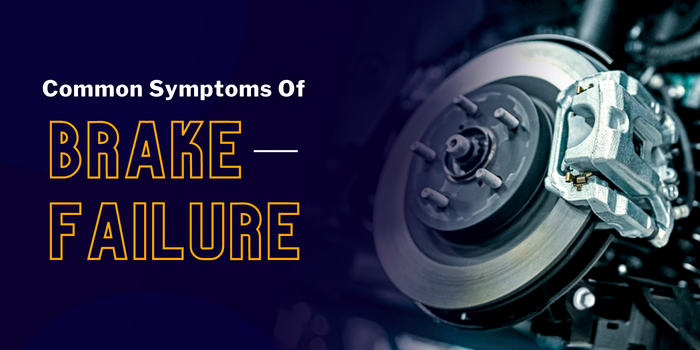
Most modern vehicles have all-four wheel braking system supported by a hydraulic system, in addition to electronic assistance like ABS and ESP. Brakes can be disc or drum operated but they serve the same purpose of slowing down a vehicle to a complete stop. Brake maintenance and servicing should be part of your regular schedule if you want your braking system to function properly. Brake problems can appear in several ways, so it is important to identify signs of brake failure early on before they become expensive repairs.
Brakes usually require professional service as they are complicated components that you may not be able to fix at home without the proper tools, equipment and skills. Be aware of the most common brake problems so that you can bring them to the notice of a certified mechanic or service station.
Click here to read about brake boosters.
Identify Common Brake Problems
Keep an eye out for brake problems before they turn into a catastrophe on the road. These signs of brake problems are easy to identify and can be rectified without much effort or cost.
Let’s take a closer look at the symptoms of failing brakes.
Screeching, Grinding or Squealing Sounds
If you hear a high-pitched squeal every time you press the brake pedal, you need to inspect your brakes. This is usually a sign of worn-out brake pads or disc rotors that need to be replaced. Foreign objects like pebbles can sometimes get lodged into the brakes and cause these screeching sounds. Worn-out brake pads have metal underneath and this will cause a squeaking noise as it makes contact with the spinning rotor. Replacing the brake pads is an easy fix for this brake problem.
The Vehicle Steers to One Side While Braking
Defective braking systems may apply uneven pressure on the right- and left-hand side brakes, causing the car to pull to one side causing instability while driving. The brake callipers and brake pads need to be inspected to solve this issue. Hydraulic system problems could also cause the car to steer to one side while braking.
Pulsating Brake Pedal
Warped disc rotors that are bent out of shape will result in pulsating vibrations in the brake pedal, car body and steering wheel under light and heavy braking. Brake disc rotors can wear out unevenly with constant use causing them to vibrate when the brake pads make contact with them. Braking force is also non-linear and you may find it uncomfortable to slow down the car due to the deep rumble. The disc rotors need to be ground to a smooth surface and checked for wobbling before being re-installed. Damaged disc rotors need to be replaced.
Check here Reasons to service your car on time
Instrument Cluster Warning Light
Cars equipped with an ECU have sensors in the brake system that can identify problems or signs of malfunction. This includes the ABS module which is an electronic unit to assist the driver during braking manoeuvres. If sensors detect a brake problem, the driver will see an ‘anti-lock brake’ warning on the instrument cluster which means it’s time to check out the brakes before driving again. The system is completely electronic which requires the service of a mechanic to solve it.
Loss of Hydraulic Fluid
Brake fluid is a viscous, lubricating liquid which transfers pressure from the brake pedal to the brake callipers. It is used to reduce the effort needed to apply brakes by way of a master and slave cylinder in the hydraulic system. Loss of brake fluid will result in reduced pressure, making it difficult to apply brakes and slow the vehicle down. Hydraulic fluid is filled in sealed brake lines that prevent moisture and air from getting in. This air/water-tight system will start to fail if there are leaks in the lines. Look for a puddle of brake fluid underneath a parked car or around the brake pads and callipers.
Burning Odours
When brakes overheat, they may start to emit a strong odour of burning rubber. The rotors will also start to glow red hot if you continue using brakes that are overheating. Eventually, brake lines will start to rupture and leak hydraulic fluid causing total brake failure. This is also a fire hazard. Park your car in an open area if you notice these symptoms and wait for the brakes to cool down before driving.
Unreactive Brake Pedal
The brake pedal should offer a certain degree of resistance so that you get the necessary feedback when applying brakes. Brakes that feel too soft or too stiff indicate a problem with the hydraulic system or brake callipers. The brake pedal should spring back when pressure is released. If it stays down then get the brakes repaired immediately as it will be impossible to stop the car at higher speeds.
Click here to know How to replace brakes on your car?
Conclusion
Brake parts and components wear out with constant use, and need to be serviced at regular intervals for proper functioning. Although modern cars have computer and software systems that can diagnose brake problems before they become serious, it is advisable to physically inspect your brakes before you set off on a drive.
Brake failure is not an option that a safe driver would like to encounter. Routine maintenance is the best way to ensure you reach your destination without any mishaps along the way.
We hope this article helped you understand the common signs of brake problems and ways to solve them. If you found this article interesting, you may also want to check out What Is A Handbrake? Know Its Functions and What Is Hydroplaning And What Are The Dangers Involved? or visit Carorbis Blog for more.
Frequently Asked Questions
Q1. What are signs of brake problems?
Ans. Some of the common signs of brake problems start with an ABS warning light on your instrument cluster. Screeching or grinding noises from the brake callipers may occur when applying the brakes. The brake pedal may vibrate and pulsate due to uneven brake discs or drums. These vibrations may be transferred to the steering wheel as well. Look for signs of leaking brake fluid underneath the car when parked or on the brake discs, rotors or pads. Other symptoms include a soft brake pedal feel, the vehicle pulling to one side under braking and burning odour from the discs.
Q2. How do you know if your car’s brakes are faulty?
Ans. When brakes are failing, the most obvious sign is that you cannot stop effectively or in time. The braking power is severely reduced and you may have to use the parking brake to come to a complete stop. Failing brakes are a safety issue and must be repaired as soon as possible to avoid accidents on the road. Modern cars have a warning light on the instrument cluster to indicate a faulty brake system, but for older cars, you will have to inspect the brakes regularly and check for signs of wear and tear before starting off on a drive.
Q3. How to know if brakes are bad?
Ans. Brakes are bad when they fail to stop the car quickly, in other words, a slow braking response. This is most likely caused by low brake fluid, which cannot apply pressure to the brake callipers, or worn-out brakes. Inspect the brake discs for signs of damage, warping, rust or corrosion. The brake pedal may also get overly sensitive or not react at all depending on the severity of the problem. Listen for odd noises when applying brakes and pay attention to burning odours which mean your brakes need replacing. Even minor brake problems can lead to expensive repairs.
Q4. Why brake pads become hard?
Ans. Potential causes for stiff or hard brakes are a defective brake booster that cannot maintain the required pressure to apply braking force. Try switching off the car and pumping the brake pedal to check for weak pressure. The hydraulic lines in brakes sometimes leak fluid and the brake system seizes up due to a lack of lubrication and pressure. Braking force is decreased and you may have to push very hard on the brake pedal to stop the car. Seized or damaged brake callipers also cause this issue. Finally, check for moisture in the brake fluid and replace it in case it deteriorates.
Q5. What is the problem with brake dust?
Ans. Large amounts of brake dust on the callipers, pads or rotors indicate that the brakes are worn out or wearing out quickly. Brake dust is made from carbon fibre particles that rub off the pads or metal shavings from the surface of the disc rotor which can lead to further damage to the braking system. Wheels made of alloys can get corroded by brake dust, so get your vehicle inspected by a mechanic if you notice these signs of wear and tear. Wash the wheels with soap and water to prevent brake dust from damaging other components of your car.
Q6. What is brake override problem?
Ans. Brake override is a vehicle software that cuts off throttle input when both the accelerator and brake pedal are applied at the same time. The system overrides the accelerator and applies the brake to stop the car in time. Applying both pedals at the same time is considered a mistake by the driver and the system compensates for that error. If sensors detect that the driver has applied the accelerator while braking, it will disengage the throttle to allow proper braking. This can happen in emergency situations when the driver tries to slow down the car.
Q7. In a brake system problem, why the car won’t start?
Ans. The car should start even if there are problems with the braking system. There are no sensors that cut off the engine if they detect a brake failure. The two issues are unrelated and it may be a coincidence if it occurs. When you turn the ignition on, you may see an ABS symbol or ‘check brakes’ warning light on the instrument cluster, but the car should start as usual. It is good practice to test the brakes before you start off on your journey because you don’t want to encounter brake problems at high speeds.
Q8. How do you diagnose brake problems?
Ans. Begin with applying the brake pedal and checking for sufficient resistance from the pedal. Brakes should not feel too spongy, soft or unreactive. At the same time, a stiff brake pedal is a sign of brake problems. Check the brake fluid reservoir for low levels of hydraulic fluid and the correct colour. Inspect the brake lines for signs of leakage or corrosion. Have a look at the brake callipers, pads, and disc rotors. They should be clean and free of brake dust.
Q9. Why do I have brake problem in reverse?
Ans. Brake problems while reversing are usually due to the same issues which brakes have going forward. Drivers sometimes apply the accelerator while braking in reverse which could prevent the vehicle from coming to a complete stop. When braking in reverse, a different part of the brake pad comes in contact with the disc rotor. This edge may be unusually worn out, causing problems while braking in reverse.
Q10. What to do if brakes fail while driving?
Ans. If you notice brake failure while driving, immediately take your foot off the accelerator pedal and shift to a lower gear (this induces engine braking). Turn on your emergency hazard lights if you have the time and quickly pump the brake pedal to regain pressure. Engage the emergency brake (handbrake) to slow down the vehicle and steer the car to the side of the road away from other motorists. This is the safest way to avoid accidents.
Q11. How often do brakes fail?
Ans. Brake failure is quite rare because the driver will usually identify symptoms before it becomes a crisis. Brake systems should be inspected at every service interval or at least once in 6 months (10,000 km). The brake fluid level should be checked often because hydraulic fluid is the main component that keeps brakes working properly. Brakes last at least 30,000 km -40,000 km before they need to be replaced.
Q12. Why brakes fail?
Ans. The most frequent cause of brake failure is loss of hydraulic fluid in the system, either due to a leak or through constant use. With insufficient brake fluid, there isn’t enough pressure created in the system and brakes will start to malfunction. Another common cause of brake failure is worn-out brake pads and disc rotors. In this case, braking efficiency is reduced and the driver will struggle to slow down the car. Check the brake fluid often and inspect the brakes for signs of wear and tear. Test braking power before you set off on your commute. Regular maintenance and inspection is the best way to prevent or identify brake failure.







